Granada City Neighbourhoods – Where to Live?
Where to live in Granada? We had a crash course in Granada’s neighbourhoods a year ago when looking for an apartment in the city.
There are a lot of variations within neighbourhoods themselves, for example, there are parts of Realejo (one of the most popular of Granada neighbourhoods) where I would love to live…and others that I find utterly depressing. But I’ll cover the broad strokes of the main neighbourhoods of Granada and also highlight a few favorite spots.
I’ll also cover what you have to look out for when wanting to rent in Granada. Because it isn’t easy and we almost gave up in frustration. Granada has quite a unique rental market.
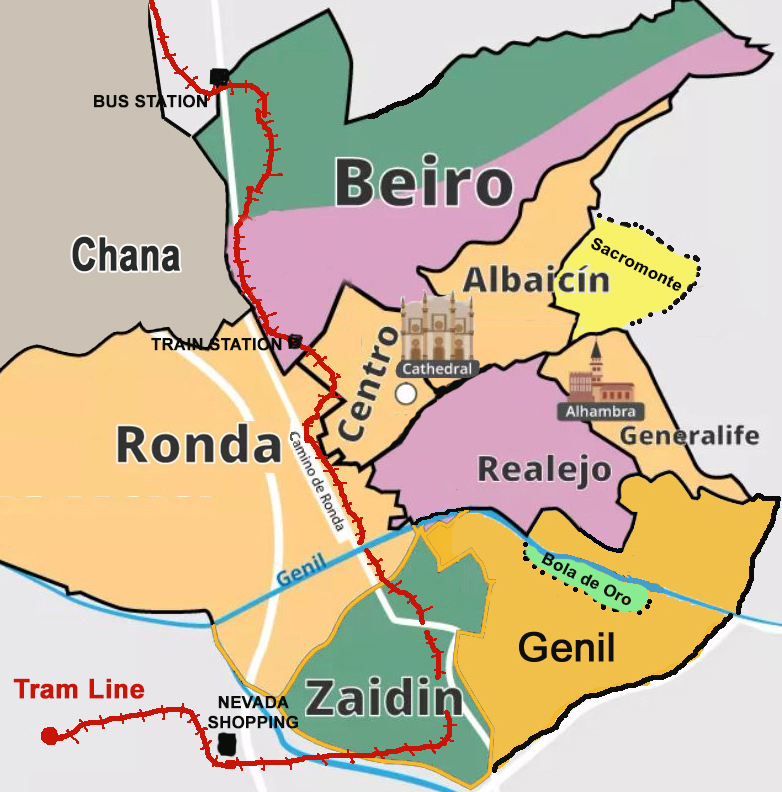
Where to live in Granada?
Realejo
Realejo one of the most popular areas in Granada, you’re right downtown here and right next to the Alhambra. It’s a busy, tight and mostly hilly area with lots of attractive historic buildings and squares (it used to be the Jewish quarter). The neighbourhood has buildings that have been updated but also a lot that could use some work. Streets are narrow, small city buses go through here on their way up to the Alhambra. Some nice squares with tapas bars and churches (Iglesia de Santo Domingo is beautiful and often overlooked).

Parking is an issue here and it gets noisy. Being such an old neighbourhood, you don’t have many larger Supermarkets but you do have tons of little stores. Prices here are high because this is a popular area. The positives are that you are right in the center of life in Granada (lots of bars and restaurants) and that you are basically in the backyard of the Alhambra.
A quick look at Idealista indicates average prices of about 1,000 Euros/mo for a nice 2-bedroom apartment on a higher floor (November 2025).
I’ve mentioned there are variations in Realejo (as there are in every neighbourhood). I like the eastern part of Realejo close to Calle Pavaneras, it has real charm. I dislike the south-western end, the streets on either side of the Carrera de la Virgen (Granada’s version of Las Ramblas as I call it). While it’s the most practical part of the neighbourhood being next to the Corte Ingles and Mercadona, it is full of soulless streets and buildings that badly need renovation.
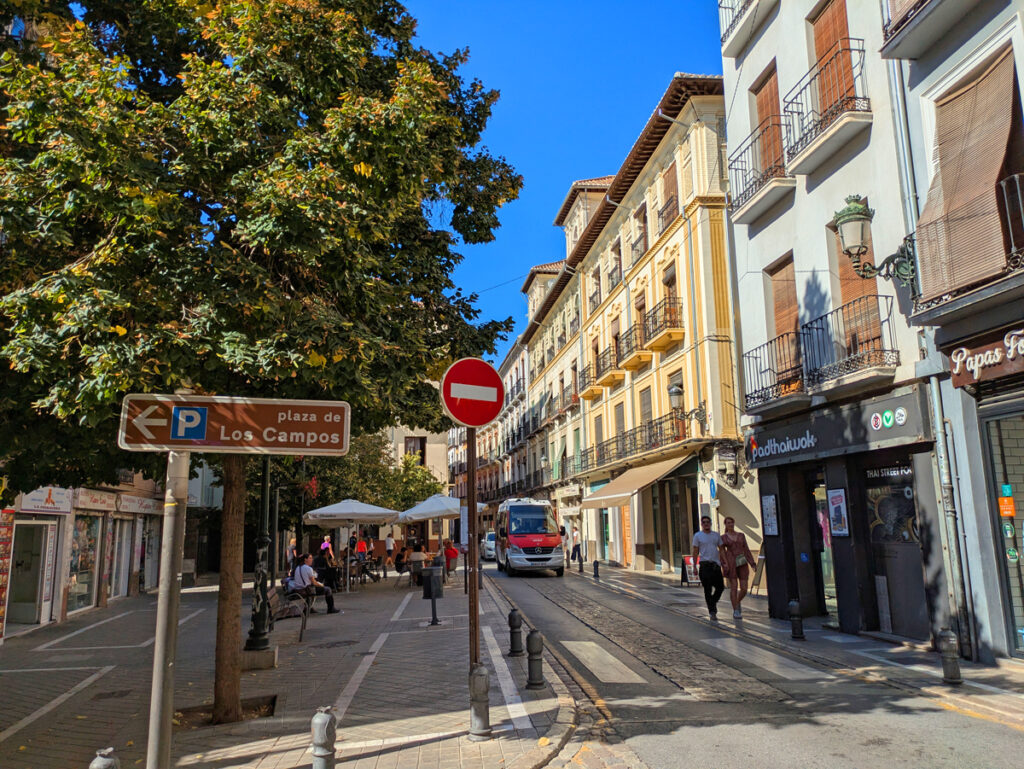
Centro
Another very desirable area. The Gran Via has some of the most desirable properties in Granada and where you’ll find most of the city’s luxury hotels. You’ll see many beautiful, historic buildings around the Cathedral and Plaza Bib-Rambla. This is definitely a beautiful part of the city of you can afford it…mind you, there’s a lot of foot traffic, locals and tourists. It’s also not practical for every day shopping. But it’s a beautiful area with squares (replete with bars, cafes and restaurants). Walking around the area is always a pleasure.
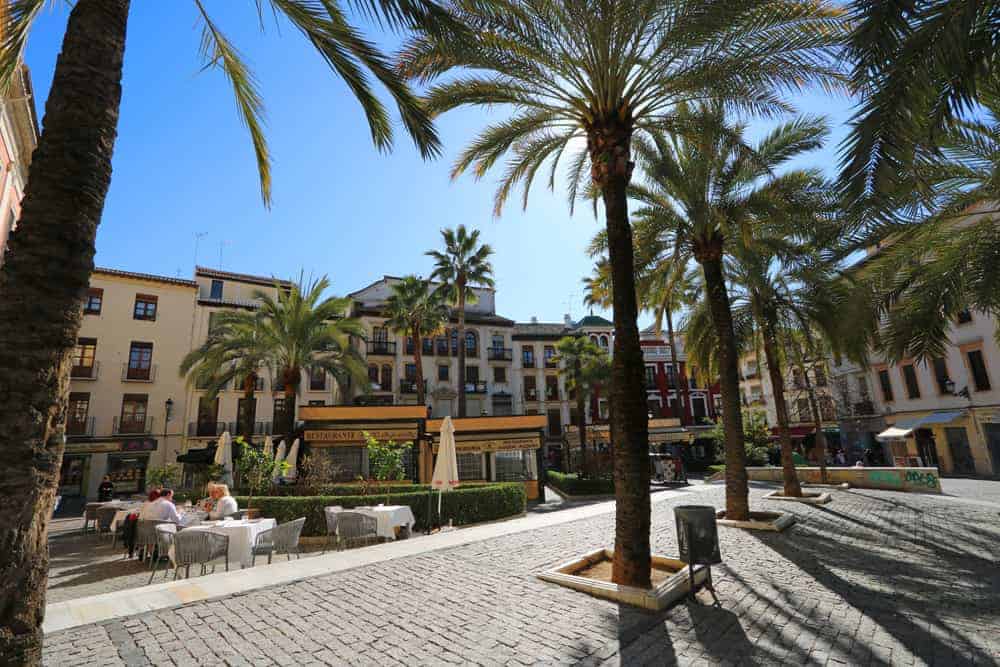
Like Realejo, expect to pay about 1,000 Euros/mo for a nice 2-bedroom apartment on a higher floor (November 2025). But also like Realejo, the problem is oftentimes finding an apartment.
The Centro gets more “modern” as you go west towards Camino de Ronda (“modern” as in ugly 1970’s style buildings, most around 5 – 7 stories). This part of the center is blue collar, full of businesses, lots of restaurants and bars. Calle Recogidas is one of Granada’s busy streets with a lot of retail stores, banks, dentists etc.
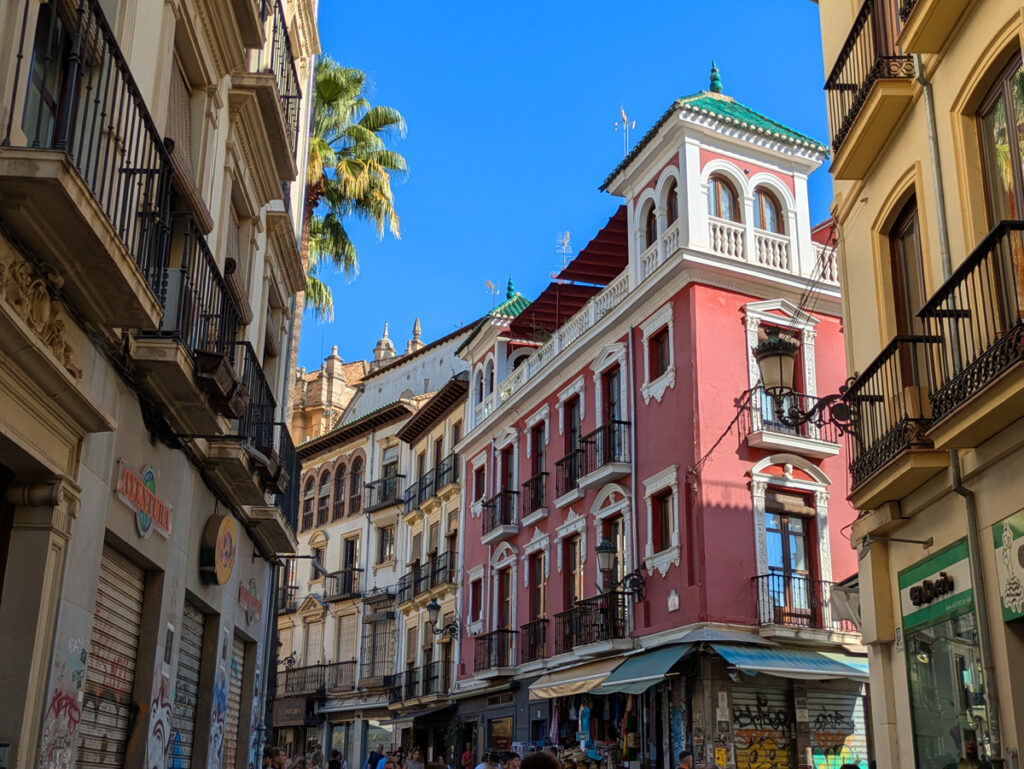
Ronda
Centro morphs into the Ronda neighbourhood at Camino de Ronda. There’s a tram station at the corner of Calle Recogidas / Camino de Ronda (they call it the Metro de Granada but it’s really a tram line with a bunch of underground stations including at the Recogidas station).
The Ronda neighbourhood’s lifeline is Camino de Ronda which fits the description I described for the lower end of Centro: busy, blue collar, full of businesses, lots of restaurants and bars. Buses run along the street, the tram runs underneath it. Buildings date back to the 1970s. It has a very local/downtown flavour if that’s what you’re looking for.
Westwards, Ronda gets more residential and is an option for people looking for something quieter and less expensive. Popular with families and students.
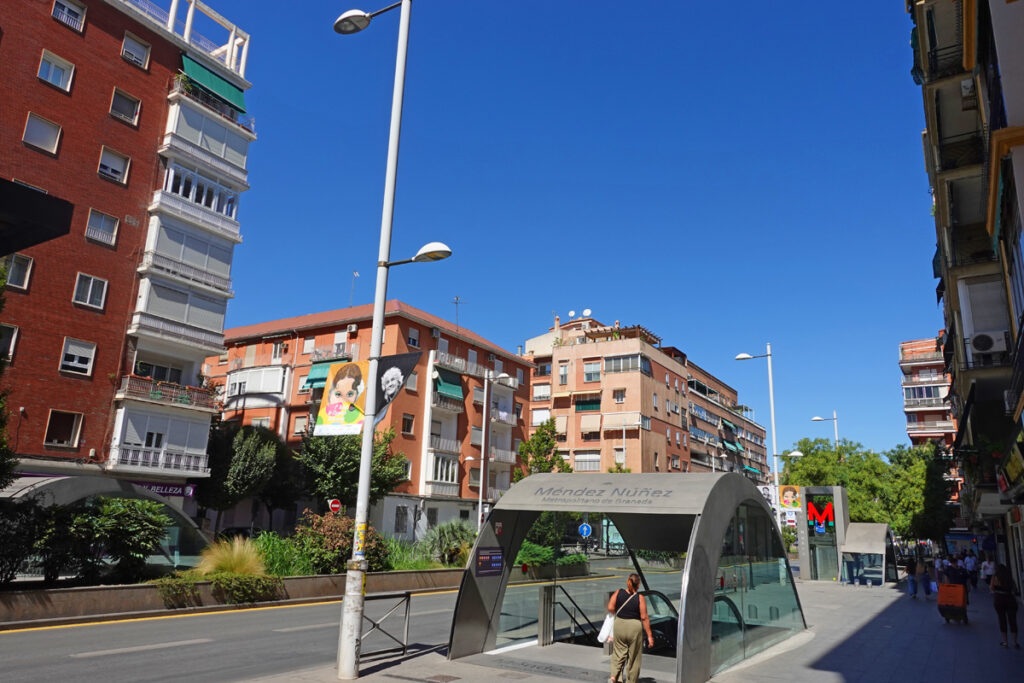
The Albaicin and Sacromonte
The Albaicin is the old Moorish quarter of Granada and it is the most visited neighbourhood with its cobblestoned alleys, great views (looking out at the Alhambra), and historic buildings. The Albaicin is a UNESCO World Heritage site.
The downside of the Albaicin is that it is a hugely inconvenient area to live in. There are no big grocery stores, access by car and parking are complicated, there are lots of tourists, there are lots of steps (in many spots in the Albaicin, access is only by foot). Note also, that being a UNESCO site there are a lot of restrictions on what you can do to upgrade buildings.
If you can put up with the negatives, the Albaicin has tons of charm. There are people that live here, some in gorgeously restored buildings.
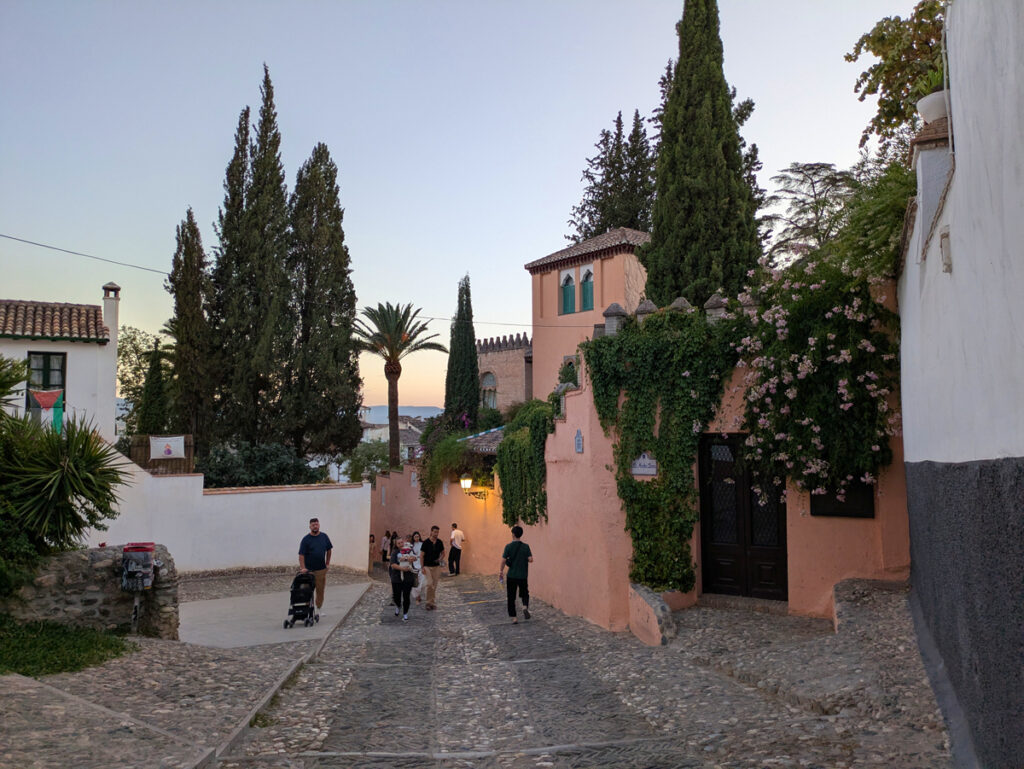
Sacromonte is technically part of the greater Albaicin but is practically a long street from which steep steps and alleys lead to whitewashed houses, many built into the cliff. If living in a Cave house is something you’ve always dreamed of, this is the area to do it.
The area used to be where gypsies lived: you’ll see their heritage in the Cave House museum of Sacromonte and in the many venues where they have flamenco shows (most in cave houses). I know of some foreigners who’ve bought cave houses and renovated them with modern amenities.
Still, Sacromonte is very difficult to access and not for most people.
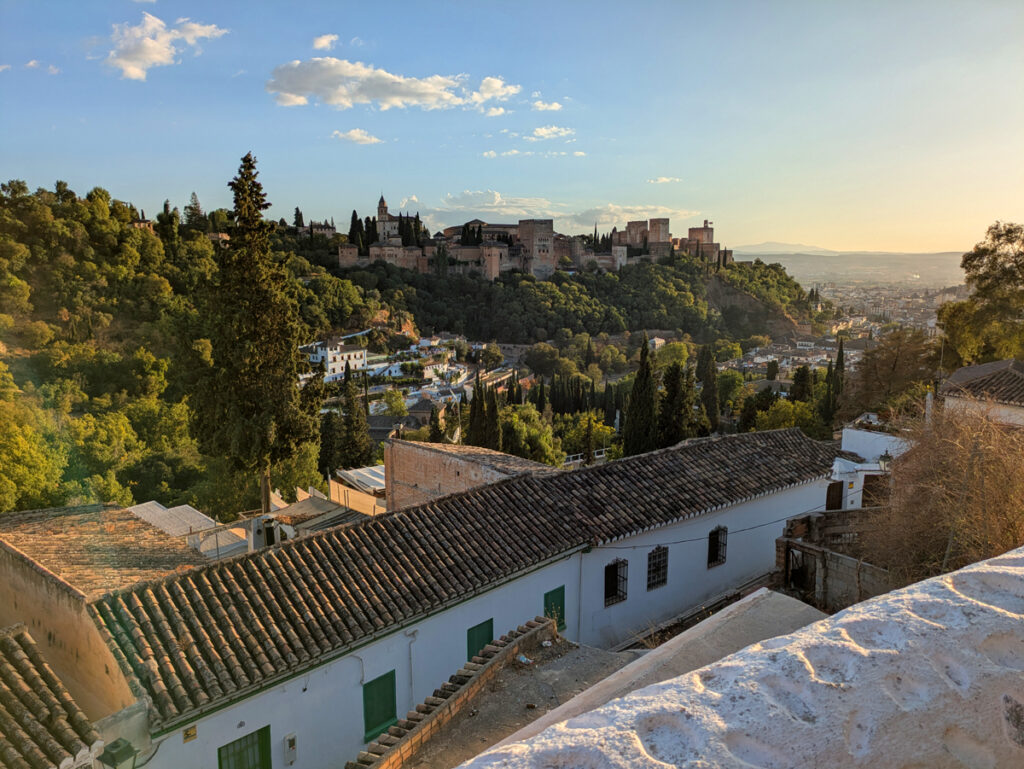
Zaidin
This is where we live in Granada.
Zaidin is one of the largest and most populated areas of Granada. It is a mix: close to the river the housing is quite dense. Getting further into the neighbourhood, it gets less dense but the buildings get taller. Continue further and it becomes residential with low storey buildings. So there’s a bit of everything.
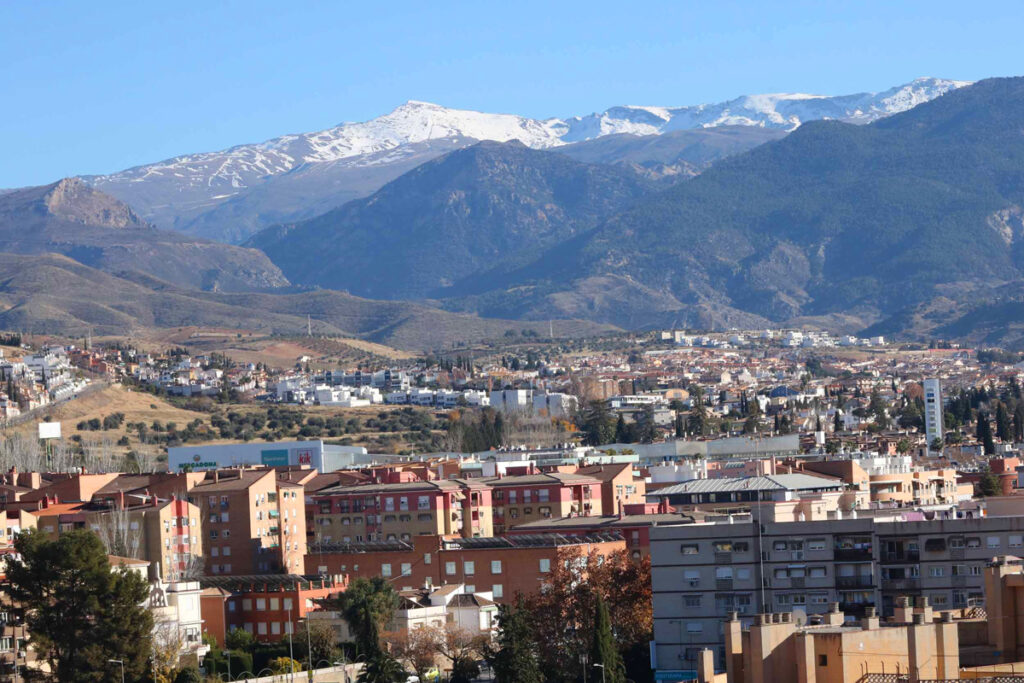
While not in the center, much of the neighbourhood is an easy walk to the center of Granada. It takes us 15 minutes to walk from our home (next to the Hipica tram stop) to the center. The tram runs through here (taking us to the train station and bus station, or, in the other direction, to the Nevada Shopping Center). You also have lots of buses coming through. If you have a car, the neighbourhood is modern and residential enough to drive and park. Finally, you have all the day to day amenities in this area: several supermarkets, lots of restaurants, tapas bars, cafes. Etc. It is a very practical area to live in and on top of that prices are reasonable (We found a 3 bedroom apartment here on the 10th floor for 800 Euros).
Negatives? Well, you aren’t in the center and it’s not a beautiful neighbourhood. It’s not ugly, but it’s not beautiful.
PS. Having lived here 18 months now, we really like the area around the Andrés Segovia tram stop. There are some slightly more modern apartment blocks, lots of nice and more trendy restaurants and bars (including our favorite Sushi restaurant), a sports complex across the street, and all the same conveniences that we have in our area (granted, we’re just a 10 minute walk away).
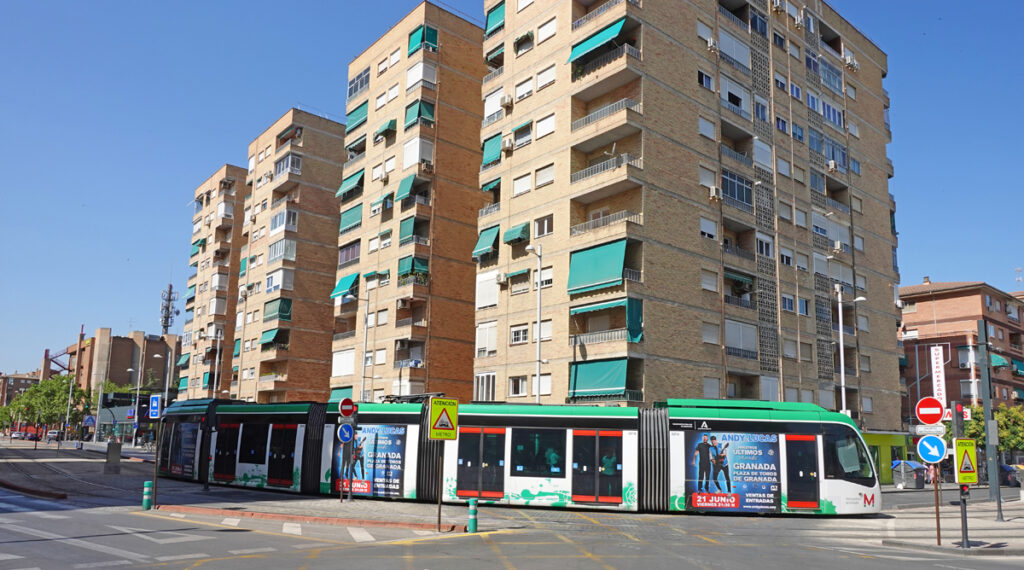
Genil
The neighbourhood right next to Zaidin. It’s actually our favorite neighbourhood in Granada…we tried to get an apartment in this area but couldn’t find anything we liked.
Genil is more residential than Zaidin and has more green spaces. One of our favorite streets is Avenida de Cervantes, a pretty street lined with trees, modern low-level housing (as well as high rises) and lots of little businesses. But the highlight of the area for us is Bola de Oro, a subsection of Genil running by the river. There people stroll, jog, and walk their dogs. There’s a huge sports complex and you can play tennis, basketball or do any number of activities. And you’re an easy 15 minute walk to the center of Granada.
The downside of Genil? There are no major supermarkets (the closest is Mercadona which is about 15 minutes away by walking). They do have smaller supermarkets however like Coviran and Tu Super.
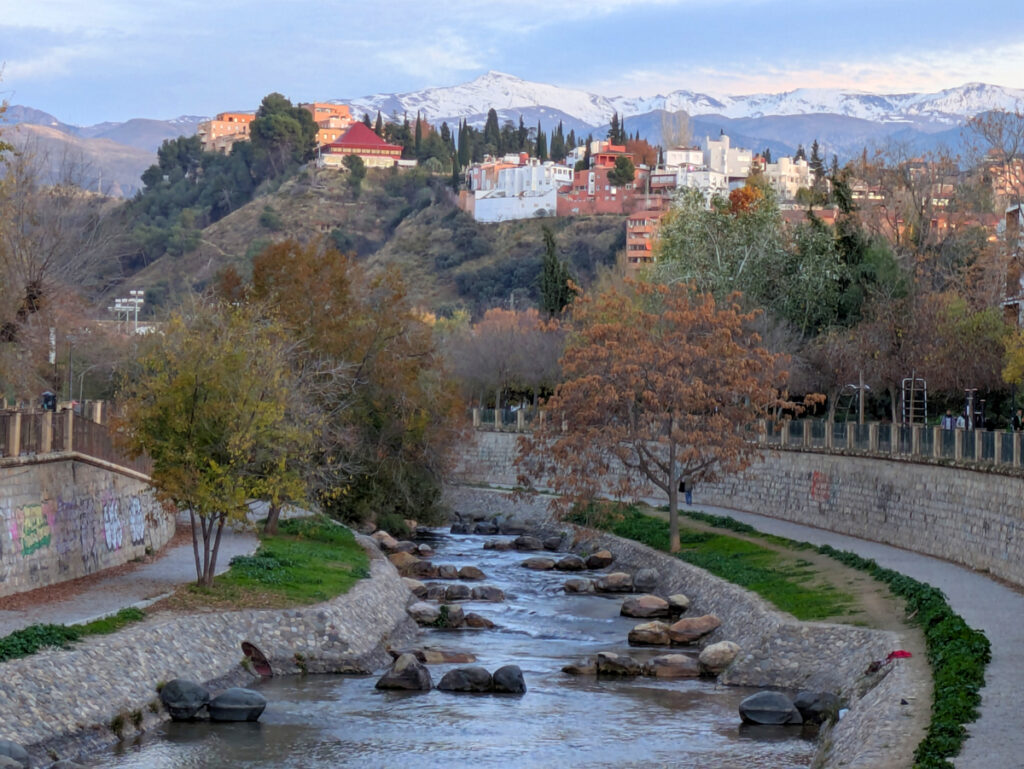
Beiro
There’s a mix of everything in Beiro. It’s a popular area for students because of the University of Granada campus (a very clean, green area right next to the Cartuja Monastery). In spots, it is very urban and busy (and unattractive), in other spots (such as around the Plaza de Toros), it is quite nice. Walking Avenida de la Constitucion from Caleta tram stop to Jardines del Triunfo is one of the nicest walks in Granada. As I say, it’s a mixed bag, the southern end being more attractive than the norther end.


Granada has a challenging Real Estate Market
There are a few things that make Granada a challenging real estate market.
The first is that it’s a student town and a lot of apartments are earmarked for students. They fall under short-term contracts (Arrendamiento para Uso Distinto de Vivienda), have a maximum period of 1 year, non-extendable, and don’t benefit from tenant protections under the LAU (Ley de Arrendamientos Urbanos ie Urban Leases Act). Landlords who rent to students are not interested in renting long-term, much less to foreigners.
The 2nd is that many landlords look for a “nómina”, or payroll in English. Most older expats (like us) no longer work and don’t have a payroll from an employer. You can have a million Euros in the bank and landlords won’t look at you, they want a nómina. Oftentimes it’s not because they’re being difficult, it’s because they have a tenant insurance policy with a financial institution that requires them to get a nómina from the tenant. In expat towns along the coasts it’s not an issue because the market is different and landlords are used to working with foreigners. But in the interior it’s different – and that makes it particularly hard in Granada because not only do they require a nómina, but it is also a very competitive rental market.
As I mentioned up top, we almost gave up on Granada. How did we get an apartment? We offered to pay 6 months rent upfront. Doing that got our foot in the door and landed us a few apartment viewings. In the end we got lucky – the apartment we are renting is owned by someone who used to work in the Ministry of Immigration. He knew our situation being here on a Non-Lucrative Visa and understood why we didn’t have a nómina. He was also happy with the idea of getting 6 months rent up front.
This post covers in detail our experience finding an apartment in Granada: Finding an apartment in Granada. Things learned.
This post is also a must-read before signing off on a rental contract: Your rental rights in Spain (and what to look out for)
A couple of extra tips on renting an apartment in Granada:
- Granada gets cold in the winter and hot in the summer. Make sure you have heating and AC (note: we don’t have AC. I’m not sure how we missed that when we visited but at that point we were pretty desperate to find a place).
- Granada is not very big and is very walkable. Don’t let the idea of being in Zaidin or Beiro dissuade you, you might only be a 15 -20 minute walk from the center. Also, public transport is very good with most buses passing every 10 to 15 minutes.
- If you have a car, I’d really think hard about renting an apartment in Centro, Realejo, or the Albaicin. It’s not just the driving (narrow streets) but the lack of parking.
Related: Our Cost of Living in Granada (2025)


When we were in Granada last month, we stayed in the Bola de Oro area. I really loved it there. Close to the Genil river, along which it’s an easy and nice walk to the city center. It’s also very quite there. We loved the atmosphere and free tapas at Mamut. 🙂
We agree on the area 🙂
A question Frank. I know it’s not easy to find a place in Granada but is there a reason not to go a bit outside of Granada, like you have Armilla? From what I can see, there seems to be a lot more available. I might be wrong though. And a side question… how do I get my avatar in here 🙂
Hi Carlo. Honestly haven’t been to Armilla, it’s quite a way out of the center. The furthest we’ve been is the Sierra Nevada shopping center and that’s already on the fringes of the city. But as long as it’s on the tram line, not to far to get into the city.
For the avatar, you would usually set that up on your email. If it shows up on your email profile, then it should show up when you comment on the blog
i am wondering how you manage the heat in the summer, i am not referring inside the apartment, but more in the day to day. i have Spanish friends, even from Bcn, that it’s also very warm, saying that Granada is much worse, with the feeling that you cannot breath.
When we also were on holiday in Asturias, we found people native from Granada escaping the heat.
Hi Rosa! You do like the locals: go out early in the morning and later in the evening. The rest of the day you stay home with all the shutters and blinds down, like a vampire 🙂
But Granada not as bad as Seville or Cordoba. They’re even hotter!
Ahhh good to know that it is not too bad 🙂
I love Granada!